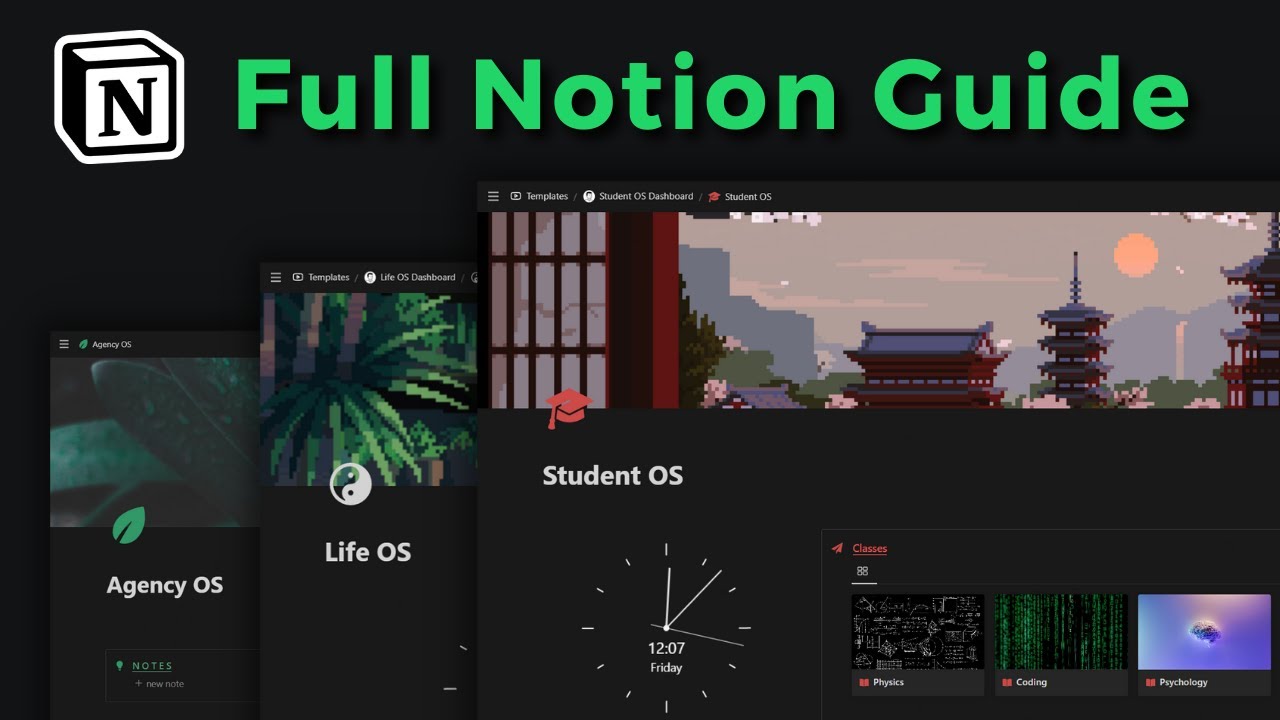Boost Your Productivity with Notion: The Key to Financial Freedom for Fathers is a comprehensive video guide by Chris’s Notion that will take you from a beginner to a pro in just 20 minutes. Notion is an all-in-one workspace that combines notes, tasks, wikis, and databases, making it a powerful tool for organizing your work and personal life. This video covers everything you need to know about Notion, including its features such as icons, covers, templates, keyboard shortcuts, tables, and quick find option. It also explores advanced topics, like creating and customizing pages, editing blocks, using tables and databases, and managing different views. Whether you’re new to Notion or looking to take your productivity to the next level, this video will help you become a Notion pro and achieve financial freedom.
The video also provides tips and helpful resources for using Notion effectively, such as using Notion databases for various tasks, filtering and sorting databases, grouping entries, mentioning pages or team members, creating backlinks, and sharing Notion pages with others. It also explores advanced features like synced blocks, linked databases, and using Notion API for automated workflows with external apps. If you want to boost your productivity and take control of your life, this video is a must-watch. Sign up through the affiliate link in the description to support the channel and start your journey towards financial freedom with Notion.
1. Notion Basics
Notion is a versatile all-in-one workspace that allows you to organize your notes, tasks, wikis, and databases in one place. Whether you’re new to Notion or want to level up your skills, this article will guide you through the basics of using Notion effectively.
1.1 Getting Started with Notion
Before diving into the features of Notion, it’s essential to familiarize yourself with the interface. Notion has a clean and intuitive design that makes navigating the workspace easy. In this section, we’ll walk you through the basics of getting started with Notion.
1.2 Exploring Notion’s Interface
Notion’s interface is highly customizable, allowing you to personalize your workspace according to your preferences. From personalizing your dashboard to creating templates and layouts, this section will cover everything you need to know about customizing your Notion workspace.
1.3 Navigating Notion’s Features
Notion offers a wide range of features to help you manage your tasks and projects efficiently. In this section, we’ll explore how to create and organize tasks, use kanban boards and timeline views, and collaborate with team members on projects.
2. Customizing Your Workspace
One of the distinct advantages of Notion is its flexibility and customization options. In this section, we’ll delve into personalizing your dashboard, creating templates and layouts, and maximizing the use of icons and covers to customize your workspace.
2.1 Personalizing Your Dashboard
Notion allows you to personalize your dashboard by adding icons and covers to your pages. We’ll guide you through the process of adding icons and covers and share some resources where you can find pre-made icons and covers.
2.2 Creating Templates and Layouts
Templates and layouts are powerful tools in Notion that can help you save time and streamline your workflow. We’ll show you how to create templates for different tasks and customize layouts to suit your needs.
2.3 Maximizing the Use of Icons and Covers
Icons and covers not only enhance the visual appeal of your Notion pages but also provide a quick way to identify and navigate through your content. In this section, we’ll explore different ways to maximize the use of icons and covers in your workspace.
3. Managing Tasks and Projects
Notion offers robust task and project management capabilities. In this section, we’ll cover how to create and organize tasks effectively, utilize kanban boards and timeline views, and collaborate with team members on projects.
3.1 Creating and Organizing Tasks
Notion provides various tools to create and organize tasks efficiently. We’ll guide you through the process of creating tasks, using tags and properties to organize them, and setting reminders to stay on top of your tasks.
3.2 Using Kanban Boards and Timeline Views
Kanban boards and timeline views are powerful features in Notion that allow you to visualize and track the progress of your tasks and projects. We’ll show you how to create kanban boards and timeline views and utilize them to manage your work effectively.
3.3 Collaborating on Projects with Team Members
Notion makes it easy to collaborate with team members on projects. We’ll explore how to assign tasks, leave comments, and use the @mention feature to communicate and stay organized as a team.

This image is property of i.ytimg.com.
4. Utilizing Notion Databases
Notion databases are a versatile tool for organizing and managing data. In this section, we’ll explain what Notion databases are, how to customize them for different tasks, and how to filter, sort, and group database entries.
4.1 Understanding Notion Databases
Notion databases are a powerful tool for storing and organizing data. We’ll explain the basics of Notion databases and how they can be customized to suit different tasks and workflows.
4.2 Customizing Databases for Different Tasks
Notion databases can be customized to fit various use cases. We’ll show you how to structure and customize databases to efficiently manage different types of information, from project tracking to content calendars.
4.3 Filtering, Sorting, and Grouping Database Entries
Notion provides powerful filtering, sorting, and grouping options for managing large amounts of data. We’ll walk you through the process of filtering, sorting, and grouping entries in your Notion databases to easily find and organize information.
5. Mastering Blocks and Layouts
Blocks are the building blocks of Notion, allowing you to create rich content and layouts. In this section, we’ll explore Notion’s block system, creating multi-column layouts, and utilizing mentioning, links, and backlinks.
5.1 Working with Notion’s Block System
Notion’s block system allows you to create various types of content, from headings to to-do lists. We’ll guide you through the different types of blocks and how to use them effectively.
5.2 Creating Multi-Column Layouts
Multi-column layouts can help you organize and present information more efficiently. We’ll show you how to create multi-column layouts in Notion and make the most out of this feature.
5.3 Using Mentioning, Links, and Backlinks
Mentioning, links, and backlinks are essential features in Notion for cross-referencing and connecting your content. We’ll explain how to use these features and harness their power for a seamless workflow.
6. Sharing and Collaborating
Notion makes it easy to share and collaborate on pages with others. In this section, we’ll cover how to share Notion pages, collaborate in real-time with team members, and utilize Notion Web Clipper and synced blocks.
6.1 Sharing Notion Pages with Others
Sharing Notion pages with others allows for collaboration and feedback. We’ll show you how to invite others to view and collaborate on your Notion pages and explain the different access levels available.
6.2 Collaborating in Real-Time
Notion’s real-time collaboration feature enables seamless collaboration with team members. We’ll explore how to collaborate in real-time, leave comments, and track changes made by team members.
6.3 Using Notion Web Clipper and Synced Blocks
Notion Web Clipper and synced blocks are powerful features that allow you to save and sync external content seamlessly with your Notion workspace. We’ll explain how to use these features and integrate external content into your Notion pages.
7. Integrating with External Apps
Notion can be integrated with various external apps and services to enhance productivity. In this section, we’ll introduce Notion API and integration software, guide you on how to connect Notion with Google Calendar, and explore creating custom systems using the Life OS Dashboard.
7.1 Introduction to Notion API and Integration Software
Notion API and integration software enable seamless workflows between Notion and external apps. We’ll provide an introduction to Notion API and guide you on how to connect Notion with integration software like Zapier or Integromat.
7.2 Connecting Notion with Google Calendar
Integrating Notion with Google Calendar allows you to sync your events and tasks seamlessly. We’ll walk you through the process of connecting Notion with Google Calendar and syncing your calendar data.
7.3 Creating Custom Systems and Using Life OS Dashboard
Notion’s flexibility allows you to create custom systems and utilize tools like the Life OS Dashboard to streamline your workflow. We’ll explore how to create custom systems in Notion and leverage the Life OS Dashboard for enhanced productivity.
8. Leveraging Notion for Financial Freedom
Notion can be a powerful tool for boosting productivity and achieving financial freedom. In this section, we’ll cover how to use Notion templates to enhance productivity, create recurring entries for daily journaling and habit tracking, and automate workflows using Notion API and integration software.
8.1 Boosting Productivity with Notion Templates
Notion templates provide a starting point for your projects and help streamline your workflow. We’ll show you how to leverage Notion templates to enhance your productivity and save time.
8.2 Creating Recurring Entries for Daily Journal and Habit Trackers
Recurring entries in Notion can be used for daily journaling and habit tracking. We’ll guide you on how to set up recurring entries and track your progress using Notion’s features.
8.3 Automating Workflows with Notion API and Integration Software
Notion API and integration software can automate workflows and save you time. We’ll explore how to use Notion API and integration software to automate tasks, such as syncing Notion calendar with Google Calendar and updating Notion databases with external data.
9. Exploring Additional Resources
Notion offers a wealth of resources to help you explore its advanced features and find inspiration for your projects. In this section, we’ll introduce Notion video tutorials for advanced features and Notion template libraries for inspiration.
9.1 Notion Video Tutorials for Advanced Features
Notion video tutorials provide in-depth guidance on advanced features and workflows. We’ll share some recommended video tutorials that cover advanced Notion features to help you level up your skills.
9.2 Notion Template Libraries for Inspiration
Notion template libraries are a great resource for finding inspiration and pre-designed templates for various use cases. We’ll point you to some popular Notion template libraries where you can explore and find templates that suit your needs.
10. Conclusion
By following this comprehensive guide, you should now have a solid understanding of Notion’s basics and be able to navigate its features confidently. Whether you’re a beginner or seeking to level up your Notion skills, Notion’s flexibility and customization options make it a powerful tool for organizing your work, personal life, and everything in between. Get started with Notion today and unlock a world of productivity possibilities!




